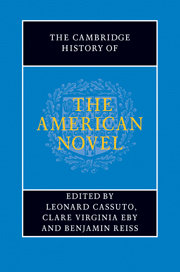Book contents
- Frontmatter
- General Introduction
- PART ONE INVENTING THE AMERICAN NOVEL
- PART TWO REALISM, PROTEST, ACCOMMODATION
- PART THREE MODERNISM AND BEYOND
- Introduction: modernism and beyond
- 37 Stein, Hemingway, and American modernisms
- 38 The Great Gatsby and the 1920s
- 39 Philosophy and the American novel
- 40 Steinbeck and the proletarian novel
- 41 The novel, mass culture, mass media
- 42 Wright, Hurston, and the direction of the African American novel
- 43 Ellison and Baldwin: aesthetics, activism, and the social order
- 44 Religion and the twentieth-century American novel
- 45 Faulkner and the Southern novel
- 46 Law and the American novel
- 47 Twentieth-century publishing and the rise of the paperback
- 48 The novel of crime, mystery, and suspense
- 49 US novels and US wars
- 50 Science fiction
- 51 Female genre fiction in the twentieth century
- 52 Children's novels
- 53 The American novel and the rise of the suburbs
- 54 The Jewish great American novel
- 55 The Beats and the 1960s
- 56 Literary feminisms
- 57 Reimagining genders and sexualities
- PART FOUR CONTEMPORARY FORMATIONS
- A selected bibliography
- Index
50 - Science fiction
from PART THREE - MODERNISM AND BEYOND
Published online by Cambridge University Press: 28 July 2011
- Frontmatter
- General Introduction
- PART ONE INVENTING THE AMERICAN NOVEL
- PART TWO REALISM, PROTEST, ACCOMMODATION
- PART THREE MODERNISM AND BEYOND
- Introduction: modernism and beyond
- 37 Stein, Hemingway, and American modernisms
- 38 The Great Gatsby and the 1920s
- 39 Philosophy and the American novel
- 40 Steinbeck and the proletarian novel
- 41 The novel, mass culture, mass media
- 42 Wright, Hurston, and the direction of the African American novel
- 43 Ellison and Baldwin: aesthetics, activism, and the social order
- 44 Religion and the twentieth-century American novel
- 45 Faulkner and the Southern novel
- 46 Law and the American novel
- 47 Twentieth-century publishing and the rise of the paperback
- 48 The novel of crime, mystery, and suspense
- 49 US novels and US wars
- 50 Science fiction
- 51 Female genre fiction in the twentieth century
- 52 Children's novels
- 53 The American novel and the rise of the suburbs
- 54 The Jewish great American novel
- 55 The Beats and the 1960s
- 56 Literary feminisms
- 57 Reimagining genders and sexualities
- PART FOUR CONTEMPORARY FORMATIONS
- A selected bibliography
- Index
Summary
Stories of warning and wonder
The mutant mind-reading robot in Isaac Asimov's “Liar!” (1941) wants to know about the human world that so puzzles him. Accordingly, as he explains to robopsychologist Susan Calvin, science books “just don't interest me. There's nothing to your textbooks. Your science is just a mass of collected data plastered together by make-shift theory … It's your fiction that interests me. Your studies of the interplay of human motives and emotions.” As Asimov (and his robot) knew, there was much to learn from fiction about the laboratory of life. “Science fiction,” as the genre was defined and developed in the early to mid twentieth century, grew out of a faith in the revelatory and speculative power of fiction, which could help to fathom and probe the scientific discoveries and technological innovations that lay beyond contemporary understanding. Its initial proliferation in popular culture made it a “pulp” genre appealing more to devoted fans than to literary critics, but increasingly science fiction has drawn attention both from literary critics and from scientists intrigued by the unique formulations, speculations, and theories offered by the most sophisticated examples of the genre. As the titles of the early magazines devoted to science fiction make clear, amazement, wonder, and awe are key words of the genre, but it is wonder inspired by the possibilities of science that distinguishes science fiction from the literature of fantasy. The speculation associated with the genre emerges from cognitively plausible – if sometimes far-reaching – scenarios that imaginatively engage and potentially challenge the most unquestioned scientific assumptions about human capacity and the world.
- Type
- Chapter
- Information
- The Cambridge History of the American Novel , pp. 832 - 846Publisher: Cambridge University PressPrint publication year: 2011



